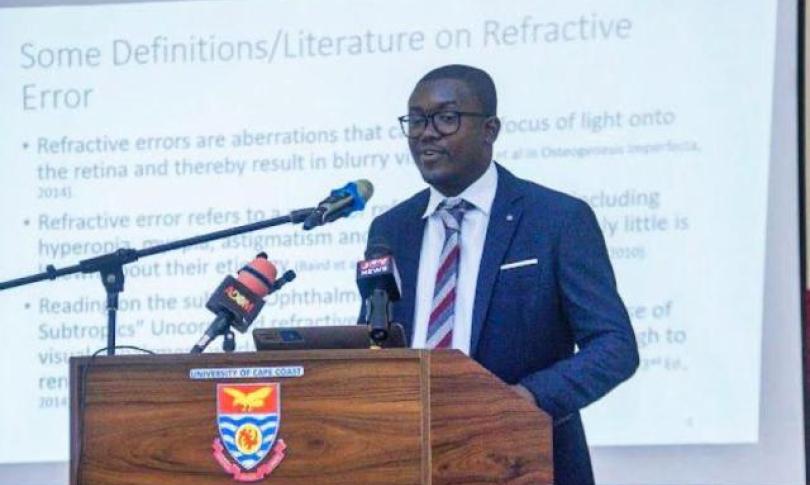
Cape Coast, Ghana- Outdoor games in most African settings like pampanaa, pilolo – were types of outdoor games handed down to generations until technology emerges. Experts say, these local outdoor games might have saved many children from eye diseases collectively known as refractive errors in the past. Now it is the era of computers, tablets and mobile phones for both young and old, and excessive use of these gadgets puts pressure on the eye.
Refractive errors, - are type of vision problem that makes it hard to see clearly. This comes as a result of structure formation of the eye. Refractive errors, including myopia, hyperopia, astigmatism, and presbyopia, affect the eye's ability to focus light properly on the retina, resulting in blurred vision. These conditions are highly prevalent worldwide, leading to moderate to severe vision impairment. Studies show that uncorrected refractive errors are the second most common cause of blindness globally.
Modernization is shaping many society in diverse ways and Africa is inclusive, most children in urban settings are getting blind by the day due to excessive indoor activities and near works, says, Samuel Kyei- Associate Professor of Clinical Optometry at the University of Cape Coast.
“You get into homes and children are on tablets and adults on phones. You no longer wants your children to play outside especially those in cities”.
Our so-called Montessori schools are without playgrounds for children any longer, these are all contributive factors, says Kyei.
Mary Doe a mother of three has observed her daughter who just turned three is complaining of not seeing at a certain distance. Upon medical examination it was confirmed she’s suffering from myopia- short sightedness. “I don’t really know what happened my last girl who just turned three is been complaining”. We went to the hospital and she was diagnosed of myopia, she said.
Often seen as simple physical disorder, have emerged as a significant public health issue with huge implications for national development. According Samuel Kyei, this misconception that refractive error is not a disease has led to its underestimation in public health priorities.
In a study conducted by Asare & Mojaria, 2021in some selected regions in Ghana among children of school going age- children age 6- 12 years confirms one out of every eight five children is with one of the eye conditions.
“In Ghana, the prevalence of myopia among schoolchildren ranges from 1.8% to 7.5%, with higher rates observed among those seeking eye healthcare services. This situation not only limits educational and occupational opportunities but also exacerbates poverty and economic disparity”.
According to Fredrick Asare, the lead author even though the commonness of refractive error in this study is lower the reported cases in different parts of the country’s health facilities is more with most of them even underreported. “These figures are lower than what is reported at the various facilities in the country”
Unfortunately none of these errors among children have had correction, he added.
Despite this, refractive errors have been relegated to the status of minor eye defects rather than serious health conditions.
Traditionally, global health initiatives have focused on non-communicable diseases (NCDs) such as cardiovascular disease, cancer, diabetes, and chronic respiratory diseases.
However, recent shifts have included eye health conditions among critical areas of concern. Refractive errors, along with cataracts, glaucoma, and age-related macular degeneration, are now recognized as significant contributors to the global NCD burden.
The economic implications of uncorrected refractive errors are staggering. In low- and middle-income countries like Ghana, where access to vision care is limited, the consequences extend beyond individual health to national productivity. Uncorrected myopia alone is responsible for an estimated global productivity loss of USD 244 billion annually.
Dr. Kyei emphasizes that sight loss due to refractive errors can lead to job loss, reduced productivity, and early retirement. This decline in workforce participation can slow GDP growth and increase healthcare costs due to accidents or the need for ongoing care. The economic burden extends to reduced output in agriculture, manufacturing, and services, contributing to lower wages and heightened poverty levels. "Sight loss not only affects individual livelihoods but generates broader societal economic burdens," says Kyei.
Addressing refractive errors requires a multifaceted approach. Investment in corrective eyewear and vision care services is not just a health priority but a strategic economic decision. Enhancing the coverage and quality of refractive services can mitigate the economic losses associated with visual impairment and promote overall national development.
The global community must acknowledge the critical role of vision health in achieving sustainable development goals. By prioritizing the correction of refractive errors, we can unlock human potential, enhance productivity, and foster economic growth. Investing in the correction of refractive errors is not just a health priority but a strategic economic decision, Kyei concludes.
